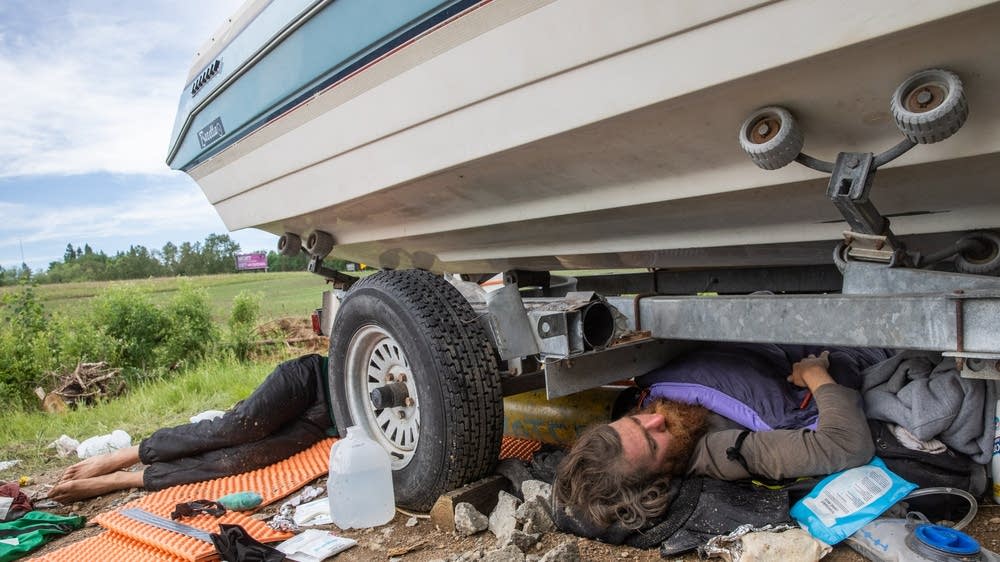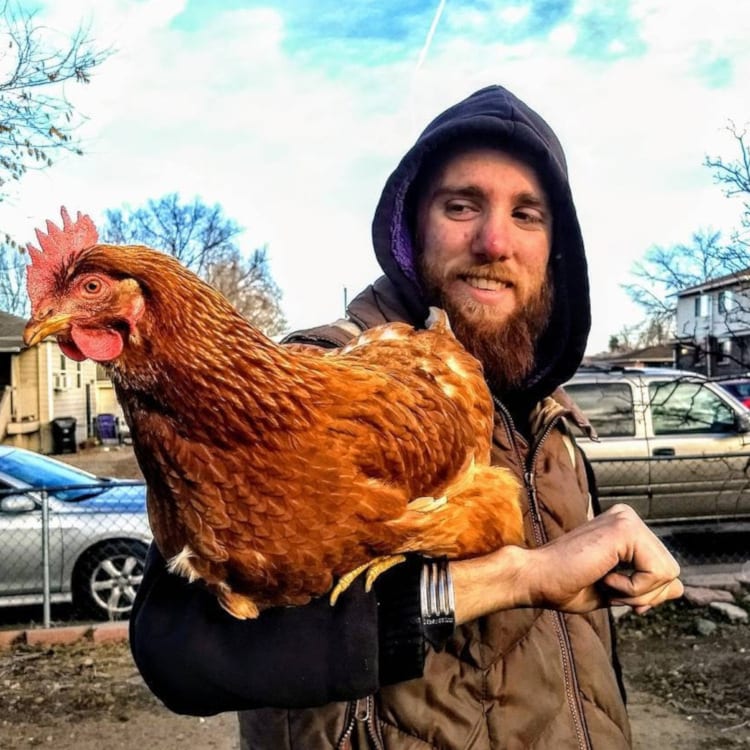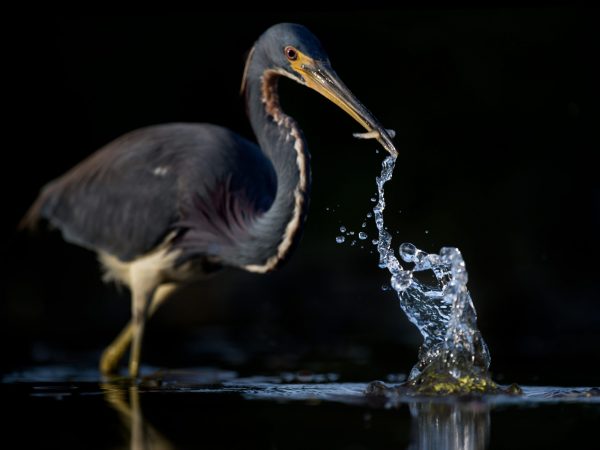Kristin: What do you think the Dharma brings to the space of engagement, of action and advocacy?
Aidan: One of the obstacles holding movements back from actualizing their potential is internal conflict stemming from the way that people are showing up. My teacher, Kanko Sensei, says we swim in a river of trauma, and that totally appears when people show up in movement spaces. In so many ways, movement spaces can be profoundly therapeutic and that’s one beautiful reason to create them and to step into them. In other ways they can be profoundly triggering because it’s stepping towards many of the things that have created the trauma that we’re experiencing. One moment can be healing but also retraumatizing.
What practice can offer to social movement spaces in the most immediate and ordinary sense is getting in touch with your inner experience, noticing when you’re reacting to something. Learning, developing a practice to regulate your emotional state is key for moving into these extremely intense environments, especially direct action movements.
So there’s that element and, I guess, stepping into Thich Nhat Hanh’s concept of interbeing, Dharma answered the why for me. Without Dharma, the work that I’ve been drawn towards in the animal freedom space could have been kind of a hobby or a side pursuit. I loved studying music. Art is wonderful and it makes life worth living. At the same time, there came a time when I just couldn’t reconcile that with what it felt like Dharma was calling me to do.
Kristin: What, in your mind, does the animal freedom movement instruct, correct, even chasten the Dharma to do?
Aidan: People may or may not agree with this, but for most people involved in the animal movement it feels like kind of the orphan of the left or the orphan of the social movement space. You can step into social movement spaces, or kind of any just socially engaged space, and people will rattle off a list of causes that are all related to each other and all matter, and animals tend to be omitted from that list.
I’m open to the possibility that I’m the one who’s standing in the way of justice. I show that I’m serious about reconciliation by being willing to listen deeply to an opponent’s perspective without giving up.
But to start answering your question, I want to bring in Dr. King. One thing that’s really been pivotal for me, as I’ve spoken about integrating the spiritual with the socially engaged aspect, has been this lineage, curriculum, body of work called Kingian nonviolence. This is essentially a community of people who worked to keep Martin Luther King’s legacy alive by teaching his philosophy and his work.
Dr. King is such an important person for Buddhists who are interested in social engagement. King had a profoundly non-dualistic worldview, more so even than many mainstream Buddhists. Obviously his vocabulary was a product of his context as a Christian minister in the American south in the 1950s and sixties. He really believed deeply, and genuinely put into practice, that there was a grain of truth in every perspective, including the KKK or whoever his most vicious opponents were at the time.
He believed that a nonviolent campaign was never over until the opponents of that campaign had actually been brought back into the fold of the beloved community and won over. While we’re in the act of resistance, we’re constantly keeping the door open to reconciliation, and we don’t want to do anything that closes that door. We’re always trying to reach out to win over the heart of the person who’s standing in the way of justice. Even go so far as to say, I’m open to the possibility that I’m the one who’s standing in the way of justice. I show that I’m serious about reconciliation by being willing to listen deeply to an opponent’s perspective without giving up.
Kristin: The other thing that I hear you speaking to, which is pulling on the threads of Dharma practice and trauma, is Dr. King’s approach to self-regulation, what he called the discipline of entering into these spaces of conflict and preserving the opportunity for reconciliation.
Aidan: I think of King as one of my most important Dharma teachers. In our training we share an anecdote that in a number of King’s campaigns it became a norm that, as they were organizing the community, they would circulate an agreement that you had to sign in order to participate. One stipulation of this agreement was that you will meditate daily on the life and teachings of Jesus. What Gandhi called self-purification, King gave it a different name because he didn’t think that would land well in the West. It’s always good to adjust our language, for Dharma folks to think about how we can be understood by the mainstream.
When people look back on the kind of commitment that the civil rights movement or Gandhi’s movement in India were able to draw out of their participants, the kinds of sacrifices that people made to participate, anything that activists face today in some ways pales in comparison; the beatings that people took, or so many people who gave their lives to create a change. When we look at that today, we’re just in awe. How can we create that kind of commitment in people today? If you look back at the record, those people who made those sacrifices are very straightforward, very clearly communicating what motivated them, which was a deep, deep spiritual conviction. You couldn’t imagine the same thing happening without, for the civil rights movement, talking about God and what is God’s justice and what it meant to be doing God’s work.
Kristin: A lot of what we’ve been speaking of here is the space of understanding and discipline and ways of looking that inform advocacy direct action in your life; I’m hearing the philosophical underpinnings and also the ways that you personally hold these. And then the rubber meets the road, it takes actual shape, it manifests. You’ve been participating in the direct actions with Line 3 and working with the various communities that are coming together there, and I’m wondering if you can speak to how that convergence happens and how you found yourself drawn to be part of protesting.
Aidan: I love the framing of this question, making that differentiation between where there’s philosophy and then where there’s practice and the hour, the season for each of them. That was highlighted for me in my experience in Minnesota with the Line 3 movement, that it wasn’t the time for philosophizing. My own doorway into Line 3 was Standing Rock, where I spent four nights in November, 2016, just a couple of weeks after the election. It was a transformative experience for me. I remember within days of coming back, I was describing it as I felt like I’d seen the best and worst or the brightest and darkest of what these social movements can look like.
It was just an intense, shared purpose and clarity, and amazing level of trust with people that you don’t know anything about. I’ve never experienced anything like it in any other space.
On the one hand, there was this incredible collective energy, like nothing I’d ever experienced, where you’re in this camp with 3000 complete strangers and you don’t guard your campsite. It was like you got up in the morning, someone’s walking around saying ”Hey, we need 10 people to come work on this, build this thing over here.” Okay, well, that’s what I’m doing today. You work alongside people you’ve never talked to before and you’re never going to talk to again. You just had this total feeling of unity with people. Even with belongings, you just lost the sense of possessiveness; leave your gloves somewhere and someone else is going to pick them up and use them, and I’ll just pick these ones up and use them. There were just so many goods and gifts being donated to the camp and there’s just this incredible beauty to that.
Then at the same time, I’d been paying attention online and had seen some of the signs of the sort of rifts growing within the camp which in so many ways have to do with what we’ve been talking about with Dr. King. There was a faction associated with the tribal council and elders who very much wanted to focus fully on prayer and be very peaceful and cooperative. And then there was a much more radical faction calling itself Red Warrior Camp, which was inclined not just towards direct action, but towards sabotage and kind of clandestine stuff. Ultimately the camp was heavily infiltrated by state actors and they grabbed onto those existing fault lines and exacerbated them. That sort of tore the movement apart, which happens all too often.
Essentially, these different philosophies or different orientations are ages old, it’s the same dynamic that King was dealing with. King wove a third way through, which was radical, confrontational, but profoundly nonviolent direct action. I was very excited to see that in the Line 3 movement. There were not any of the same signs of factionalism between those two camps that I saw in Standing Rock. In fact, I saw exactly the kind of open, above ground, profoundly confrontational direct action that would make him proud.
Kristin: Let’s zoom down to Aidan in this context at Line 3, the story of your experience there, what you did, what that was like, maybe how your Dharma practice played a role in the way that you were able to be present in the midst of a “conflict by design.”
Aidan: I can do that by just talking about the day of our action, taking over a site on Line 3 that was constructing a pumping station. It’s a big pipeline, and they have to build stations intermittently along the route that add pressure into the system to keep oil moving through it. We were with a group of several hundred people who were very loosely organized in different teams that didn’t have any kind of insight into what other teams were planning or doing. The team that I was with was essentially in charge of blocking a road into the pumping station.
The climax of the trip for me was spending about 19 hours chained underneath a boat blocking a road to the construction site. There were about 15 of us, and our arms were threaded through all these gigantic steel tubes so they had to cut us out with angle grinders.
I was there for a long time. It was probably the most fun, joyful experience I’ve had in years. People expect it to be stressful or somber, and I think there are times in direct action that need to be somber. But I think it also needs to be joyful and fun. This is where direct action and movement participation can be so therapeutic, so profoundly liberating from all the pressures and expectations that society is putting on you. We talk and think about, “What does sacred direct action look like?” Sometimes that question brings to mind sacred rituals, a temple context, something focused and somber and quiet. There’s so much beauty to that. I am interested in what it looks like to bring that energy to direct action spaces, but I think that often sacred ritual-type direct action can be messy. I spent a few months in London embedded with Extinction Rebellion during their October rebellion in 2019. There was this wonderful irreverent attitude, this complete discarding of internal and external shackles.
One person really can’t do much. That’s true.
So don’t be one person.
I felt that same energy lying down, still, surrounded by friends and allies. These were people who I knew better than the people at Standing Rock, but ultimately the thing that united us and created this solidarity wasn’t knowing them particularly well. It was just an intense shared purpose and clarity, an amazing level of trust. I’ve never experienced anything like it in any other space.
Kristin: Did you experience fear or even just plain old exhaustion? How did you work with the challenging, or was it just all beautiful joy running through your system in that gorgeous defiance of ecological violence?
Aidan: In some ways the lead-up to this action was probably the most stressed I’ve ever been before an action.
But once we were in position and locked into this gigantic 180-pound steel tube, there was no longer anything else for me to do, my responsibility was gone. There’s this membrane, this threshold from, “It’s about to happen,” to, “Okay, it’s happening.” And then it’s just the same as dropping in on the cushion.

Kristin: What do you think direct action, the edge of the eco-social justice movement, really needs to learn now and put into action? What’s the thing we need to stop doing and start doing?
Aidan: I think movements need to think very seriously about whether it’s more important to see your ideals acted out perfectly within your movement space or to build power, to contest the political terrain. What I mean is that there has become a huge contest within so many movement spaces around ideological and intellectual purity. By far the most destructive force within movements that I’ve seen is a kind of intellectual rigidity. I’m only 26 so I know this is not speaking from personal experience, but what I hear from elders is that the left in the fifties and sixties was a place of radical openness to ideas. Now I find it to be an incredibly intellectually rigid space where there’s almost a script around what good politics looks like. It’s actually very superficial and one-dimensional and internally inconsistent.
Kristin: We eat our own now, right?
Aidan: Movement spaces have become totally violent and cannibalistic. That’s why I find so much relief that I can turn to elders like King and other intellectual ancestors and movements like Act Up to find answers. They were a very deliberately non-identitarian space. It’s not always an either-or; we absolutely need to be scrutinizing how some status quo patterns are showing up in our movement spaces. One example of a status quo pattern showing up is white supremacy, but another is a kind of ideological and intellectual hegemony where there’s a right way of thinking. If you don’t think that way, then you get purged. Conformity valued over curiosity.
Kristin: What inspires you? Who inspires you? What keeps you going?
Aidan: I have actually integrated movement work into my rhythm in a way that I’m not relying on inspiration. Coming to terms with what’s happening every day, what our systems and institutions are doing every day to non-human animals and the kind of heat and fieriness it produced in me was what got me involved in movements. It’s what got me to set aside the life that I thought I was going to have, and music, which I still think of as the biggest sacrifice I made. But that wouldn’t have been a particularly sustainable way to live, having that kind of intensity, that kind of heat around it.
It’s just not as hard as you think. It might look really scary but it’s really not.
You’re going to be okay.
I’m actually now in a different place, and would love to share a little bit about being part of a small startup organization called Pax Fauna. We’re trying to overhaul many aspects of the strategy and approach of the grassroots animal freedom movement as it exists right now. We work nine to five and have tried to create more normalness in our rhythms. I get to the end of a workday and I stop. I go do other things that are going to allow me to do this for 10 or 20 years. I think inspiration is super important to find, but in the long-term, it’s more about building rhythm.
Kristin: So many of us feel the want to do more, and at the same time, feel powerless to manifest that. How do you respond to this concern of, ‘I’m just one person, what can I do?’
Aidan: One person really can’t do much. That’s true. So don’t be one person. Find one of the movements and be part of it. It’s not going to be perfect. And it’s not going to look exactly how you would like. We’re in the process of essentially trying to incubate and create a new mass movement organization. It’s not about doing it the perfect way or whatever you think is the perfect way. It’s about doing something and being part of something that’s steering the ship in the right direction. That connects back to the question earlier about what movements need to stop doing, which is expecting perfection or expecting the organization to exactly mirror your highest ideals. That’s not what it’s for. Be glad to have people around you that you can tolerate, that you have enough in common with in terms of what kind of work you want to do.
Kristin: If you could invite people to learn about one thing, try one practice, take one action, what would it be?
Aidan: Go find the spiciest action you can support. On the spicy spectrum, standing on the sidewalk and holding a sign is on the low, not very spicy end, and hanging yourself from a bridge for two days, like a good friend of mine did, is on the very spicy end of the spectrum. You don’t need to jump right into hanging yourself from a bridge, but basically go find what you can do. It’s just not as hard as you think; it might look really scary but it’s really not. You’re going to be okay. There are all kinds of direct actions, so you can take the kind of risk that you are comfortable with.
Kristin: It goes with what you were saying before about lowering your expectations for just how beautiful and awesome it’s all going to be. It’s going to be human and messy and there’s going to be political infighting and all that stuff. If Dr. King was spending two thirds of his time dealing with that, and we find ourselves with half of our time in such endeavors, we’re doing great.
Thank you so much, Aidan, this has been just an amazing conversation, really rich territory. Thank you for the work that you’re doing and for the choices that you’ve made in your life, orienting yourself towards these opportunities that are calling for meaningful response. They are everywhere around us. We want to lead a meaningful life. It is on offer. I appreciate you choosing to go that route.
Members of Boundless in Motion’s Dharma of Resistance course will host a gathering in Boulder, Colorado on October 6th to bear witness to the climate destruction caused by Enbridge’s Line 3.







